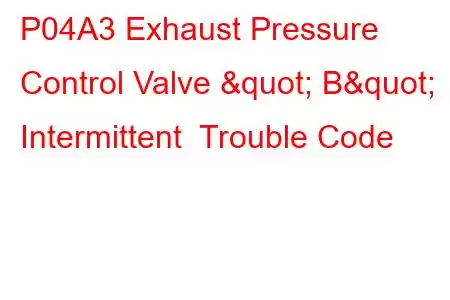P04A3 Exhaust Pressure Control Valve B Intermittent
OBD-II Trouble Code Technical Description
Exhaust Pressure Control Valve "B" Intermittent
What does that mean?
This generic powertrain/engine diagnostic trouble code typically applies to diesel engines, including but not limited to certain Ford, Dodge, Mercedes, Nissan, and VW vehicles.
This code can also apply to those trucks equipped with diesel engines and dealer installed exhaust brakes.
A valve is placed in the exhaust stream after the exhaust manifold to generate heat in the form of back pressure in the exhaust. This heat and/or back pressure can be used to assist in cold start warm up. It can also be used to oppose cylinder pressure coming from the engine cylinders out of the exhaust, thereby slowing the engine down and the vehicle along with it. This is especially useful during towing operations.
This code is strictly concerned about the incoming signal from the exhaust pressure sensor not matching intake manifold pressure or ambient air pressure during normal driving. This can be a mechanical or an electrical circuit fault, depending upon vehicle manufacturer.
Troubleshooting steps may vary depending upon manufacturer, type of exhaust back pressure control, and wire colors to the control solenoid. Refer to a vehicle specific repair manual to determine which is the "B" valve in your particular case.
Symptoms
Symptoms of a P04A3 engine code may include:
Malfunction Indicator Lamp (MIL) illuminated Lack of power Lack of engine braking Longer than normal cold engine warmup timePotential P04A3 Causes
Typically the causes for this code to set are:
Blockage in the tube from the exhaust manifold to the pressure sensor Exhaust system / Air Inlet / Charge Air leaks Intermittent open in the ground circuit to the exhaust pressure sensor Intermittent open in the signal circuit between the exhaust pressure sensor and the PCM (powertrain control module) Intermittent short to voltage in the signal circuit to the exhaust pressure sensor Exhaust Gas Pressure Sensor Possibly turbocharger overboost Possibly the PCM has failed (highly unlikely)Diagnostic and Repair Procedures
A good starting point is always a technical service bulletin (TSB) search for your particular vehicle. The vehicle manufacturer may have a PCM flash/reprogram to cover this issue, and it pays to check on this before you find you’ve gone down a long/wrong path. PCM = powertrain control module.
Next, locate the "B" Exhaust Pressure Sensor on your particular vehicle. Once located, disconnect the tube that connects the sensor to the exhaust manifold. Attempt to blow through it. If unable to, try to run a small piece of wire through it to dislodge the carbon that is trapped inside, causing the fault code you are encountering.
If the tube is clear and free, visually inspect the connectors and wiring. Look for chafing, rubbing, bare wires, burn spots or melted plastic. Pull the connectors apart and carefully inspect the terminals (the metal parts) inside the connectors. See if they look corroded, burnt or possibly green in color versus the normal metal color you are probably used to seeing. You can get some Electrical Contact cleaner at any parts store if cleaning of the terminals is needed. If this is not possible, find some 91% rubbing alcohol and a light plastic bristle brush to clean them with. Afterwards let them air dry, get some dielectric silicone compound (same stuff they use for light bulb sockets and spark plug wires) and put some where the terminals come into contact.
If you have a scan tool, clear the diagnostic trouble codes from memory, and see if this code returns. If it does not, then the connections were most likely your problem.
If the code does return, you will need to verify proper turbocharger boost
Read: 38


